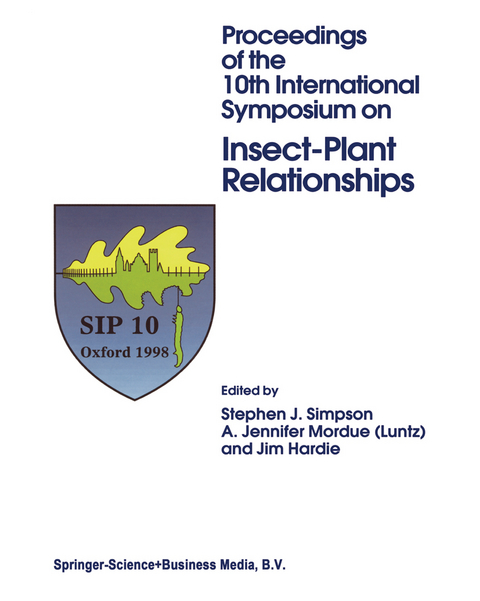
Proceedings of the 10th International Symposium on Insect-Plant Relationships
Springer (Verlag)
978-0-7923-5773-5 (ISBN)
Opening address.- Insects and plants: two worlds come together.- Central neural bases of host plant recognition.- Dynamic representation of odours by oscillating neural assemblies.- Chemo-discriminatory neurones in the sub-oesophageal ganglion of Locusta migratoria.- Chemosensory bases of host plant recognition.- Specialist deterrent chemoreceptors enable Pieris caterpillars to discriminate between chemically different deterrents.- Olfactory responses and sensilla morphology of the blackcurrant leaf midge Dasineura tetensi.- Experience-based food consumption by larvae of Pieris rapae: addiction to glucosinolates?.- Role of visual cues and interaction with host odour during the host-finding behaviour of the cabbage moth.- Integrative studies of insect behaviour.- Integrating nutrition: a geometrical approach.- Absence of food-aversion learning by a polyphagous scarab, Popilliajaponica, following intoxication by geranium, Pelargonium × hortorum.- Examining the hierarchy threshold model in a no-choice feeding assay.- Anomalous stylet punctures of phloem sieve elements by aphids.- Acceptability of different species of Brassicaceae as hosts for the cabbage aphid.- Salivation into sieve elements in relation to plant chemistry: the case of the aphid Sitobion fragariae and the wheat Triticum aestivum.- Aphid responses to non-host epiculticular lipids.- Effects of Brassica oleracea waxblooms on predation and attachment by Hippodamia convergens.- Insect behaviour in tritrophic systems.- Are herbivore-induced plant volatiles reliable indicators of herbivore identity to foraging carnivorous arthropods?.- Active defence of herbivorous hosts against parasitism: adult parasitoid mortality risk involved in attacking a concealed stemboring host.- Induction of cotton extrafloral nectarproduction in response to herbivory does not require a herbivore-specific elicitor.- Flowers in tri-trophic systems: mechanisms allowing selective exploitation by insect natural enemies for conservation biological control.- Plant defences.- Wound-induced increases in the glucosinolate content of oilseed rape and their effect on subsequent herbivory by a crucifer specialist.- Pyrrolizidine alkaloid distribution in Senecio jacobaea rosettes minimises losses to generalist feeding.- Insect life histories and plant growth responses.- The population ecology of Amorbus Dallas (Hemiptera: Coreidae) species in Australia.- A galling aphid furnishes its home with a built-in pipeline to the host food supply.- Choosing host plants: mechanism and evolution.- Vive la variance: a functional oviposition theory for insect herbivores.- Microbial partners in insect-plant associations.- The assimilation and allocation of nutrients by symbiotic and aposymbiotic pea aphids, Acyrthosiphon pisum.- How nutritionally imbalanced is phloem sap for aphids?.- Genetic bases of host plant associations.- It’s about time: the evidence for host plant-mediated selection in the apple maggot fly, Rhagoletis pomonella, and its implications for fitness trade-offs in phytophagous insects.- Behavioural correlates of genetic divergence due to host specialization in the pea aphid, Acyrthosiphon pisum.- Using hybrid and backcross larvae of Papilio Canadensis and Papilio glaucus to detect induced photochemical resistance in hybrid poplar trees experimentally defoliated by gypsy moths.- Ostrinia spp. in Japan: their host plants and sex pheromones.- Genetic basis for established and novel host plant use in a herbivorous ladybird beetle, Epilachna vigintioctomaculata.- Host-plant choice and larval growth in thecinnabar moth: do pyrrolizidine alkaloids play a role?.- Conclusion.- It’s all in the neurones.- Index of authors.- General index.- Listing of oral and poster presentations from SIP10.- List of registered participants.
| Erscheint lt. Verlag | 30.9.1999 |
|---|---|
| Reihe/Serie | Series Entomologica ; 56 |
| Zusatzinfo | VIII, 290 p. |
| Verlagsort | Dordrecht |
| Sprache | englisch |
| Maße | 210 x 279 mm |
| Themenwelt | Naturwissenschaften ► Biologie ► Evolution |
| Naturwissenschaften ► Biologie ► Ökologie / Naturschutz | |
| Naturwissenschaften ► Biologie ► Zoologie | |
| ISBN-10 | 0-7923-5773-6 / 0792357736 |
| ISBN-13 | 978-0-7923-5773-5 / 9780792357735 |
| Zustand | Neuware |
| Haben Sie eine Frage zum Produkt? |
aus dem Bereich


